PHOTOPERIOD AS A GROWTH MODULATOR IN Dahlia campanulata SAAR, P. D. SØRENSEN & HJERT
Main Article Content
Abstract
Dahlia is a species native to Mexico, it is considered the national flower and has several uses such as ornamental, medicinal and nutritional. In addition, due to its high content of inulin, it can be used as food for humans. The objective of this study was to evaluate the effect of photoperiod on the growth of the aerial part and tuberization of Dahlia campanulata. To be certain of their origin, dahlia plants were obtained by seed; these grew for 60 days under the following treatments: 1) short day photoperiod (SDP, 10 hours light:14 hours dark), 2) long day photoperiod (LDP, 14 hours light:10 hours dark) and 3) control (outdoor plants, 13 hours natural light on average). Treatments (photoperiods) were evaluated every 10 days, starting 10 days after transplanting (dat) under a completely randomized design with five replications and a plant as the experimental unit. Analysis of variance was applied and means were compared by the Tukey test (P ≤ 0.05). Response variables were obtained from both the aerial part and the root; at 60 dat, the length from the first node to the apex (13.2 cm), number of leaves (41.2), number of axillary sprouts (12.0) and leaf dry weight (2.1 g) were greater with LDP than with SDP; conversely, SDP produced larger diameter of main and lateral tuberous root (1.2 and 1.7 cm, respectively) than LDP. In general, the variables of plants with light adjustment were equal to or better than those of the control treatment (natural light). In conclusion, photoperiod impacts the growth of Dahlia campanulata. The long-day photoperiod promotes better growth of the vegetative part, while the short-day photoperiod favors the growth of tuberous roots

